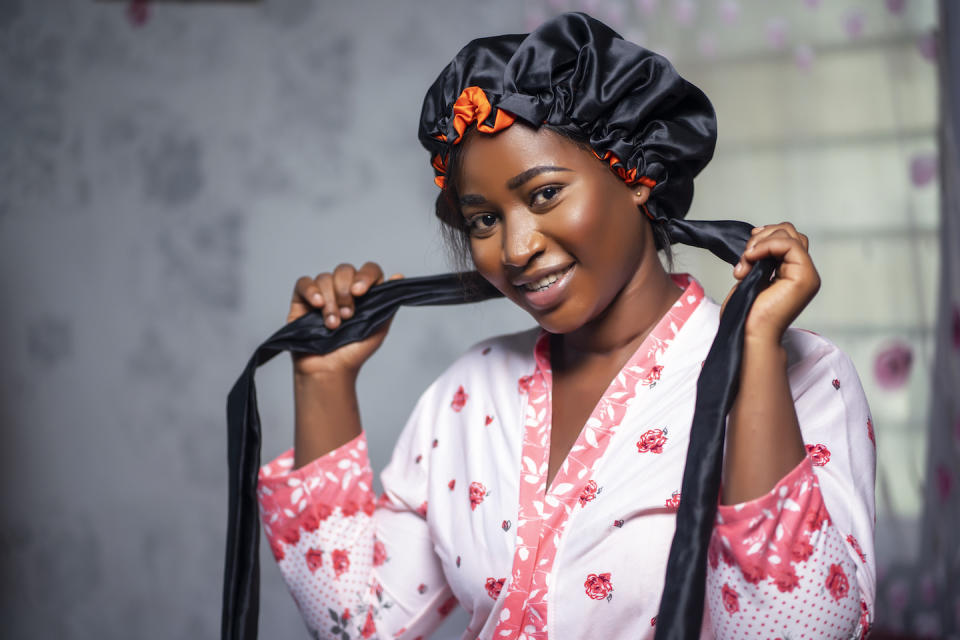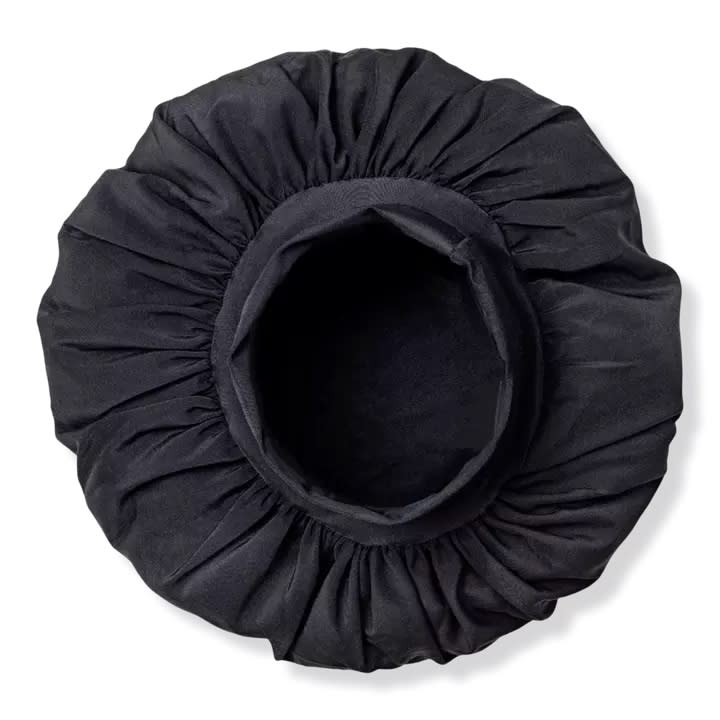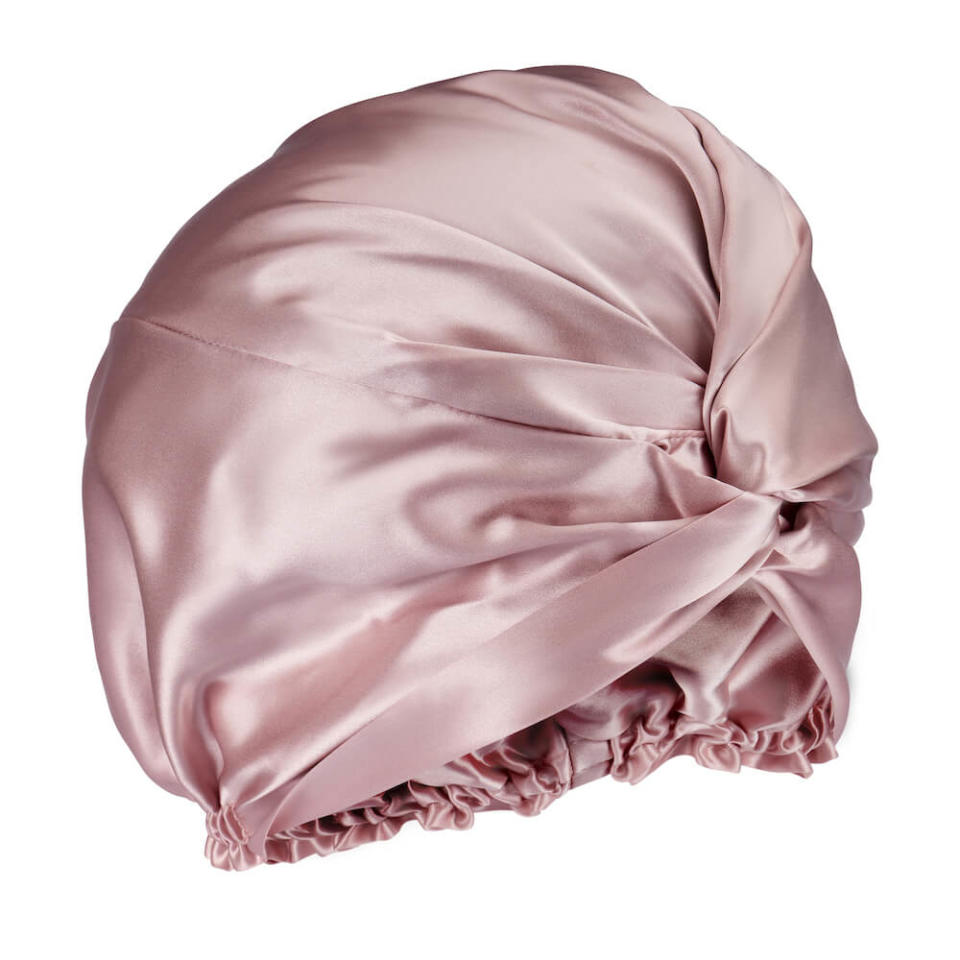Haircare Pro: Wearing a Sleep Bonnet Guarantees You Wake Up with Shiny, Frizz-Free *Gorgeous* Hair
Hot flashes, aches and pains, to-do lists — the older we get the harder it is to really enjoy a night's sleep devoid of interruptions and wake up looking and feeling refreshed. Besides the obvious signs of sleep deprivation like dark under eye circles and forehead wrinkles, tossing and turning can really wreak havoc on our hair, especially when it's fine and thinning. The secret women with thick, curly, textured hair have known for years: Wear a bonnet to sleep. But what does a bonnet do for hair, and how can it help hair look healthier? Read on to discover if a sleep bonnet is right for you.
What exactly is a hair bonnet?

Bonnets, or hair turbans, particularly ones made of silk or satin, are caps you wear to sleep that act as a barrier between your hair and the pillow case to fight frizz, tangles and breakage and preserve your hair as your head moves around during the night, explains Adria Marshall, the founder of Ecoslay, a natural haircare line.
Marshall notes that bonnets have long played a role in Black culture. Once used by African women to reflect wealth, ethnicity and other identifying factors, they were also used during slavery to identify Black women as less than other women. “Bonnets have since evolved into a helpful accessory to protect natural hairstyles, and the stigma is now gone. As a Black woman and a natural hair care entrepreneur, I wanted to add bonnets to my product list, knowing how important and symbolic hair can be in the Black community,” Marshall shares.
While a hair bonnet already an go-to hair helper for many women with coarse, curly hair, experts say women of all hair types and with many hair issues can benefit from a bonnet. For this reason, wearing bonnets to sleep has become a viral social media trend. "Curly hair is already prone to dryness, so this is a big deal for those with waves, curls, coils and kinks. The bonnet allows your hair to glide across it silk or satin fabric while you sleep, as opposed to creating friction,” she adds. This is especially important if you go to bed with damp hair, which can easily snag or break.
What does a bonnet do for you hair?
Whether your hair is curly, straight, fine or thick, you can benefit from wearing a bonnet to sleep. Here's why:
1. A sleep bonnet helps hydrate hair
Even if you are not a restless sleeper, your sheets alone can damage your hair if they have a high thread count. “Cotton sheets and pillowcases can be super drying, removing precious moisture from our hair," explains Marshall. Bonnets can be a secret weapon for sealing in moisture and helping it stay put. A silk or satin bonnet will protect your hair from the drying effects of a pillow case while keeping moisture from escaping from while you sleep. This is essential if you already suffer from dry and brittle hair.
2. A sleep bonnet helps retain volume
A bonnet can help prevent frizz, tangling and potential breakage without using messy hair masks or expensive salon treatments. “Because the bonnet acts as a barrier between your hair and the cotton on rougher pillowcase material, it helps limit the friction your hair would otherwise experience. Imagine repeatedly rubbing your hair against a cotton shirt. This is essentially what happens when you’re asleep without any protective scarf or bonnet on your hair,” says Brittany Johnson, licensed hairstylist and Senior Brand Marketing Manager at Mayvenn Hair. Instead you wake up with less breakage, softer strands and more volume.
3. A sleep bonnet helps hair look shiny
When our hair gets so dry and brittle that it frays, that’s when split ends occur and shortens the time needed between hair cuts (which translates to more money spent). Because bonnets preserve the hair’s hydration and lock in moisture from roots to ends, the instant result will be shinier strands, less damage and fewer trips to the salon.
4. A sleep bonnet helps prevent flaking
A parched scalp can lead to unsightly dry flake. Wearing a bonnet can help prevent the scalp from drying out in the first place. It’s important to note that if you tend to sweat at night or are already prone to pesky white flakes, you may want to avoid a bonnet as sweat and oils in our scalp can contribute to dandruff.
5. A sleep bonnet helps a hair style last
“Whether you’re donning a voluminous blowout, your natural curls, braids or a variety of styles in between, wearing a protective bonnet at night can drastically increase the longevity of your style,” explains Johnson. “It keeps your hairstyle in place and makes using pins, soft curlers, flexi rods or other tools easier.”
Depending on your hairstyle, it can also help cut down on heat styling time and touch-ups the next morning (i.e., no more “bed head”), supporting overall hair health and saving you precious time in the busy morning hours.
What does a bonnet do for skin?
Thinking of a hair bonnet as a skincare staple may sound strange, but believe it or not, wearing one can help keep your skin clear and clean.
"Any leave-in products or treatments that would otherwise transfer from your hair to your skin via your pillow no longer have the chance when a bonnet keeps your hair under wraps (literally),” shares Johnson. This means you could experience less blemishes and breakouts without changing anything in your skincare routine.
What should I look for in a bonnet?
A bonnet should be snug enough to not easily slip off during the night, but it should still be comfortable. If your bonnet is too tight around your hairline, you’re hurting more than you’re helping! “Look for one with a flexible, soft hairline band with a lot of stretch.
Material matters, too — bonnets crafted from silk or satin will be the most protective for your hair. And remember to keep your hairstyle in mind. If your hair is long and thick, or you wear styles with extensions, look for a bonnet with a longer cap area so that you have enough room for all of your hair to fit,” advises Johnson. You can even find one that’s adjustable or in cute colors and fun patterns.
Bonnets can range in price from around $5 for synthetic satin ones to upwards of $60 for 100% silk, like these below:

Tgin Slip Free Satin Bonnet (Buy from Ulta, $5)

Blissy Bonnet (Buy from Blissy, $67.46).
What’s the best way to wear a bonnet?
Bonnets are best worn overnight, but what you do underneath it is what counts. If you have long hair, you might consider styling it in a braid or high bun, especially if it’s wet. If you have curly or wavy hair, apply some leave-in conditioner for a hydrating boost or curl cream to keep frizz at bay. Conversely, if you blow dry it before bed, a spritz or two of dry shampoo can help keep it fresh overnight.
This TikTok shows how to easily put on a bonnet:
Are there any alternatives to a bonnet?
While a bonnet can be an inexpensive, low-maintenance, yet beneficial addition to your haircare regimen, it may not be for everyone. If you find them cumbersome or uncomfortable, opt for a silk scarf or switch your pillowcase to one made from silk.
For more on hair health, click through these stories:
The #1 Easiest Way To Reverse Thinning Hair: Clean Your Hairbrush Regularly
“I Tried Reverse Hair Washing and Was Shocked at How Thick and Shiny My Hair Looks Now”
